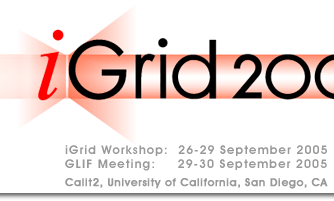News Releases
Networking researchers show their stuff at iGrid
By Jonathan Sidener
Union-Tribune Staff Writer
San Diego, CA, September 27, 2005 - Using technology that could change the face of home and workplace networking, researchers yesterday streamed ultra-high-resolution video from Tokyo to San Diego. At iGrid, Lance Long of the University of Illinois, Chicago, worked with cancer data that can be shared across high-speed networks. The image of Yuichiro Anzai, president of Keio University in Tokyo, appeared on a two-story-tall screen at the University of California San Diego as Anzai spoke with UCSD Chancellor Marye Anne Fox.
Each frame in the video contained roughly four times the resolution, four times as much digital information, as today’s HDTV.
The huge video file, moving at the speed of light across 9,000 miles of optic fiber, launched iGrid 2005, a biannual gathering of the world’s experts on high-bandwidth networking.
The trans-Pacific video and other demonstrations one moved data from Europe to UCSD at rates of up to 20 gigabits per second are significant because they foreshadow an era of essentially unlimited bandwidth, said Larry Smarr, professor of computer science at UCSD’s Jacobs School of Engineering and director of Calit2, short for the California Institute of Technology and Information Technology.
Such high-resolution video is also known as 4K digital video because it has 4,000 lines of resolution. The format has been backed by major Hollywood studios as the future of digital movies.
Videoconferencing in 4K is compelling because it is visually equal to film, Smarr said.
The technology demonstrated yesterday will make possible more than videoconferencing and the distribution of Super High Definition digital movies, he said. It will enable scientific collaborations in which researchers can simultaneously share massive data files without being in the same hemisphere.
“A lot of people have experienced videoconferencing on the Internet that is low-resolution, shaky video,” Smarr said. “It’s going out over the shared Internet, which is like driving at 5 p.m. on the freeway.”
“This is going over its own dedicated optic circuit. It’s like having the freeway to yourself.”
Theaters and corporations will soon want dedicated fiber circuits, Smarr said. Ultimately, homeowners will too, he said.
“It’s a window to the future,” Smarr said of the big-screen teleconference. “I don’t think it’s so crazy to say that people will want a gigabit, fiber connection to their homes. With the popularity of home theaters, and as content becomes available, people are going to want connections with a thousand times the bandwidth of their cable modems.”
There are only a few 4K video cameras in the world, and two of them, a pair from Olympus, were used to shoot yesterday’s demonstration in Tokyo, said Laurin Herr, president of Pacific Interface, an Oakland company that coordinated the optic network.
Similarly, there are few 4K video projectors. Sony lent one to UCSD for the event. Herr said the video signal would be routed from Tokyo to Chicago, switched to a network running from Chicago to Seattle and finally moved via a third network from Seattle to San Diego.
University of Tokyo engineering professor Tomonori Aoyama said the iGrid conference serves as something of a touchstone for networking researchers, reminding them how quickly their field advances.
“Five years ago I hosted iGrid,” Aoyama said. “At the time, 100 megabits per second was the limit. Only five years later, we are at 10 gigabits. That’s 100 times faster.”
Media Contact:
Jonathan Sidener, 619.293.1239, jonathan.sidener @ uniontrib.com
Related Links:
www.signonsandiego.com/news/computing/20050927-9999-1b27igrid.html


